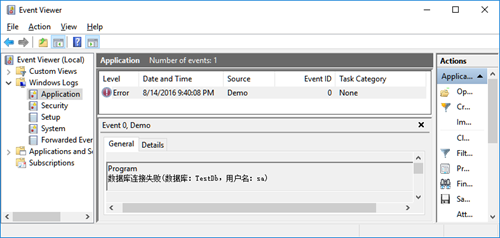面向Windows的编程人员应该不会对Event Log感到陌生,以至于很多人提到日志,首先想到的就是EventLog。EventLog不仅仅记录了Windows系统自身针对各种事件的日志,我们的应用也可以利用提供的API将日志消息写到EventLog中。与EventLog相关的API都定义在System.Diagnostics.EventLog这个类型中,我们不仅仅可以利用它读取、写入和删除日志,还可以使用它来创建和删除Event Source。.NET Core的日志模型利用EventLogLogger实现了与EventLog的集成,不过EventLogLogger使用的是一个抽象化的EventLog。本文已经同步到《ASP.NET Core框架揭秘》之中]
目录
一、抽象化的EventLog
二、EventLogLogger
三、EventLogLoggerProvider
一、抽象化的EventLog
EventLogLogger定义在“Microsoft.Extensions.Logging.EventLog”这个NuGet包中。就目前这个版本来说,该NuGet包承载的程序集只适用于.NET Framework应用,换句话说,EventLogLogger仅仅提供针对Windows EventLog的支持。尽管如此,日志模型仍然通过一个接口对EventLog的相关操作进行了抽象。
ConsoleLogger采用IConsole接口对针对不同平台的控制台进行了抽象,EventLogLogger使用的抽象化EventLog通过IEventLog接口来表示。如下面的代码片段所示,IEventLog接口仅仅定义了一个唯一的方法WriteEntry来写日志,提供的参数用于指定日志的消息文本(message)、类型(type)、事件ID(eventID)以及类别(category)。为了避免单条日志包含过多的内容,IEventLog接口定义了一个只读属性MaxMessageSize来设置日志消息的文本允许的最大长度。
1: public interface IEventLog
2: {3: void WriteEntry(string message, EventLogEntryType type, int eventID, short category);
4: int MaxMessageSize { get; }
5: } 6: 7: public enum EventLogEntryType
8: { 9: Error = 1, 10: Warning = 2, 11: Information = 4, 12: SuccessAudit = 8 13: FailureAudit = 16 14: }EventLog记录下来的没条日志都具有一个通过枚举EventLogEntryType表示的类型,这个类型相当于日志的等级。对于定义在这个枚举中的五种类型,Error、Warning和Information与同名的日志等级具有相同的含义,而SuccessAudit和FailureAudit代表针对“审核(Audit)”事件的日志,它们分别代表针对“成功事件”和“失败事件”的审核。当EventLogLogger在利用EventLog写入日志的时候,会将指定的日志等级转化成EventLog的日志类型,转换规则很简单:针对Error、Warning和Information的日志等级转换成同名的EventLog日志类型,其他的等级则之间转换成Information类型。
具有如下定义的 WindowsEventLog是对IEventLog接口的默认实现者。一个WindowsEventLog实际上就是对一个EventLog对象的封装,后者通过DiagnosticsEventLog属性表示。这个封装的EventLog对象在构造函数通过指定相应参数的日志名称(logName)、机器名(machineName)和Event Source名称(sourceName)来创建。在实现的WriteEntry方法中,这个EventLog的WriteEntry被直接调用来完成日志的写入。WindowsEventLog的MaxMessageSize属性返回一个常量31839,日志消息文本不能超过这个长度。
1: public class WindowsEventLog : IEventLog
2: {3: private const int MaximumMessageSize = 31839;
4: 5: public int MaxMessageSize
6: {7: get { return MaximumMessageSize; }
8: } 9: 10: public System.Diagnostics.EventLog DiagnosticsEventLog { get; }
11: 12: public WindowsEventLog(string logName, string machineName, string sourceName)
13: {14: DiagnosticsEventLog = new System.Diagnostics.EventLog(logName, machineName, sourceName);
15: } 16: 17: public void WriteEntry(string message, EventLogEntryType type, int eventID, short category)
18: { 19: DiagnosticsEventLog.WriteEntry(message, type, eventID, category); 20: } 21: }二、EventLogLogger
日志模型利用EventLogLogger实现了与EventLog的整合。具体来说,一个EventLogLogger实际上是对EventLog对象的封装,它利用后者向EventLog写入日志。EventLogLogger类型具有如下的定义,我们可以看到它具有两个构造函数,除了提供Logger名称之外,其中一个构造函数具有一个类型为EventLogSettings的参数,这个封装的EventLog对象正式通过该参数提供的信息创建出来的。
1: public class EventLogLogger : ILogger
2: {3: public EventLogLogger(string name);
4: public EventLogLogger(string name, EventLogSettings settings);
5: 6: public IDisposable BeginScope<TState>(TState state);
7: public bool IsEnabled(LogLevel logLevel);
8: public void Log<TState>(LogLevel logLevel, EventId eventId, TState state, Exception exception,
9: Func<TState, Exception, string> formatter);
10: } 11: 12: public class EventLogSettings
13: {14: public IEventLog EventLog { get; set; }
15: 16: public string LogName { get; set; }
17: public string MachineName { get; set; }
18: public string SourceName { get; set; }
19: 20: public Func<string, LogLevel, bool> Filter { get; set; }
21: }如上面的代码片段所示,我们可以利用EventLogSettings对象的EventLog属性向EventLogLogger提供一个具体的EventLog对象。如果这个属性为Null,EventLogLogger将会利用EventLogSettings的其他三个属性(LogName、MatcheName和SourceName)创建一个WindowsEventLog对象。除了这四个与创建或者提供EventLog对象相关的四个属性之外,EventLogSettings还具有另一个Func<string, LogLevel, bool>类型的属性Filter,它自然代表日志消息过滤器。
当EventLogLogger在利用EventLogSettings创建WindowsEventLog对象的时候,如果相关的属性(LogName、MatcheName和SourceName)在EventLogSettings对象中未作显式设置,它会采用预定义的默认值。具体来说这三者对应的默认值为“Application”[1]、“.”(代表本机)和“Application”。如果我们调用第一个构造函数重载,实际上内部会利用这些默认值创建一个WindowsEventLog对象。如果调用构造函数时连名称(name参数)都没有指定,那么类型名称(“EventLogLogger”)将被用来命名创建的Logger。
EventLogLogger和DebugLogger一样也不支持日志上下文范围,所以它的BeginScope<TState>方法和返回的对象其实毫无意义。EventLogSettings的Filter属性返回Func<string, LogLevel, bool>对象将被IsEnabled方法使用,如果个委托对象没有被显式提供,意味着这个方法总是返回True。当Log方法被调用的时候,它会采用与DebugLogger完全一致的方式来格式化最终的日志消息文本,所以针对异常的重复描述的问题依然存在。日志消息最终通过调用EventLog的WriteEntry方法被写到EventLog中,但是在这之前会检查格式化后的日志消息文本是否超过通过MaxMessageSize属性限制的长度,如果超过这个限制,日志消息将会被拆分并分多次写入EventLog。
三、EventLogLoggerProvider
EventLogLogger由对应的EventLogLoggerProvider来提供,下面的代码体现了这个类型完整的定义。我们可以调用如下所示的三个扩展方法AddEventLog来创建相应的EventLogLoggerProvider并将其注册到指定的LoggerFactory之上,我们可以通过这个方法指定用于提供或者辅助创建EventLog的EventLogSettings对象和最低日志等级。
1: public class EventLogLoggerProvider : ILoggerProvider, IDisposable
2: {3: private readonly EventLogSettings _settings;
4: public EventLogLoggerProvider() : this(null)
5: {} 6: 7: public EventLogLoggerProvider(EventLogSettings settings)
8: { 9: _settings = settings; 10: } 11: 12: public ILogger CreateLogger(string name)
13: {14: return new EventLogLogger(name, _settings ?? new EventLogSettings());
15: } 16: 17: public void Dispose()
18: {} 19: } 20: 21: public static class EventLoggerFactoryExtensions
22: {23: public static ILoggerFactory AddEventLog(this ILoggerFactory factory);
24: public static ILoggerFactory AddEventLog(this ILoggerFactory factory, EventLogSettings settings);
25: public static ILoggerFactory AddEventLog(this ILoggerFactory factory, LogLevel minLevel);
26: }我们同样通过一个简单的控制台应用来演示针对EventLog的日志记录。我们首选创建一个空的控制台应用,并在project.json中添加所需的依赖。由于针对EventLog的日志记录只适用于.NET Framework应用,所以我们仅仅为应用定义了一个针对.NET Framework 4.6.1(net461)的框架。
1: { 2: ...3: "dependencies": {
4: "Microsoft.Extensions.DependencyInjection" : "1.0.0",
5: "Microsoft.Extensions.Logging" : "1.0.0",
6: "Microsoft.Extensions.Logging.EventLog" : "1.0.0"
7: }, 8: 9: "frameworks": {
10: "net461": {
11: "frameworkAssemblies": {
12: "System.Runtime": {
13: "type": "build"
14: } 15: } 16: } 17: } 18: }我们编写了下面这段程序来完成针对EventLog的日志记录。如下面的代码片段所示,我们首先为即将写入的日志创建了一个名为“Demo”的Event Source(它一般代表日志被写入的应用或者服务的名称)。接下来我们采用依赖注入的方式创建了一个LoggerFactory对象,并调用扩展方法AddEventLog创建了一个EventLoggerProvider对象并将其注册到LoggerFactory上。我们在调用这个AddEventLog方法时指定了一个EventLogSettings对象,并将其SourceName属性设置为“Demo”。我们最终利用这个LoggerFactory对象创建出对应的Logger,并利用它写入了一条等级为Error的日志。
1: public class Program
2: {3: public static void Main(string[] args)
4: {5: if(!EventLog.SourceExists("Demo"))
6: {7: EventLog.CreateEventSource("Demo", "Application");
8: } 9: 10: new ServiceCollection()
11: .AddLogging() 12: .BuildServiceProvider() 13: .GetService<ILoggerFactory>()14: .AddEventLog(new EventLogSettings { SourceName = "Demo" })
15: .CreateLogger<Program>()16: .LogError("数据库连接失败(数据库:{ Database},用户名:{ User})", "TestDb", "sa");
17: } 18: }由于上面这段程序涉及到Event Source查看和创建,所以需要在管理员权限下才能正常运行。程序运行后查看Event Viewer,我们将会看到被写入的这条日志消息。如图10所示,由于我们调用扩展方法AddEventLog时提供的EventLogSettings并没有显式指定EventLog名称,所以我们的日志默认会写入Application这个EventLog。
[1] Windows默认提供了三种EventLog,分别是Application、System和Security,应用产生的日志只能写到Application和System日志中,Security日志是只读的。除了这三种EventLog,我们还可以为应用创建独立的EventLog。
.NET Core的日志[1]:采用统一的模式记录日志
.NET Core的日志[2]:将日志写入控制台
.NET Core的日志[3]:将日志写入Debug窗口
.NET Core的日志[4]:利用EventLog写日志
.NET Core的日志[5]:利用TraceSource写日志
